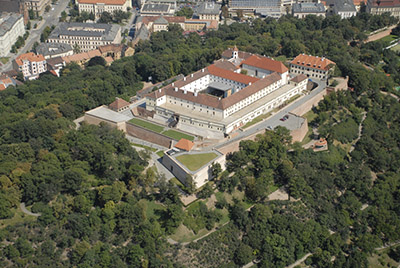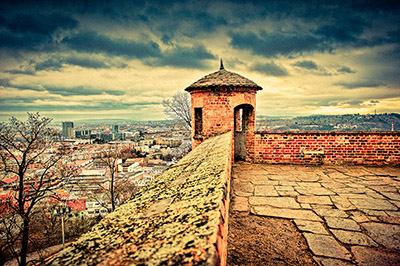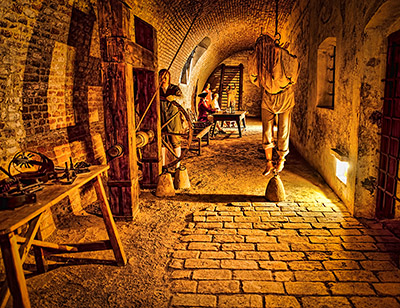 |
Špilberk Castle
Brno, Czech Republic
|
|
 |
Starfortish aspects constructed: 16th-18th century
Used by: Moravia,
Holy Roman Empire,
Austro-Hungarian Empire
Conflicts in which it participated:
30 Years' War
War of the Austrian Succession
|
The Great Moravian Empire was a Slavic state that was based around the modern border of the Czech Republic and Slovakia, from the 9th through the 13th century. A fortified settlement therein was Staré Zámky, which, in the early 11th century, was renamed Brno.
|
 |
|
|
Brno became an important center of Moravian power with the construction of an early iteration of Špilberk Castle, an actual castle, as opposed to a starfort, which is what it is now, even though it's still called a castle, which I think we can all agree that it is not. Although, really, what is a castle? Something people built before the invention of the starfort.
|
Špilberk Castle, watching o'er Brno circa 1700. Looks pretty darned impregnable to me! |
 |
The precise dates of construction for things that were built 800 years ago are difficult to pin down, but the castle around which we would get our eventual starfort seems to have been built by the end of the 1270's.
Brno was besieged in 1429 and 1430 by the Hussites, a mostly Czech people who were fighting against the domination of the Roman Catholic church. Thanks to the commanding presence of Špilberk Castle, Brno remained both uncaptured and Catholic.
Over the next century, Špilberk became an enormous financial bargaining chip. |
|
Surrendered to a variety of owners as security against a number of monetary loans, Špilberk Castle became dilapidated, its temporary custodians having little interest in expensive maintenance. This nonsense was put to an end by the city of Brno, which bought the castle in 1560 to prevent its sale to a foreign buyer. The Japanese? Eskimos? Unexplained.
|
Brno possessed the castle for only 60 years, during which time its defenses were improved (meaning it was made into a starfort). These new defensive elements served Brno well during the Thirty Years' War (1618-1648), defeating Swedish sieges in 1643 and 1645. In the early years of this war, however, Špilberk Castle had changed ownership again.
The Battle of White Mountain took place on November 8, 1620, just outside Prague. Though the battle occurred hundreds of miles from Brno, the victor, Holy Roman Emperor Ferdinand II (1578-1637), was the new master of all the Czech lands. Špilberk Castle was now a bastion of the Holy Roman Empire.
|
 |
 Those interior buildings aren't nearly as slab-sided as they once were. |
|
The Castle of our current interest finally got its chance to prove its mettle when the wicked Swedes came a-callin' in 1643 and 1645. Sweden had successfully invaded most of Moravia, but they were stopped cold at Brno, thanks to the deft defense of that starfort enpicted at the top of this page. Brno became the capitol city of Moravia by dint of its successful resistance of a three-month Swedish siege. The defeated Swedes slunk away, muttering things such as, "En pox på din själ, slottet Špilberk!"
|
 Špilberk Castle's southwest guerite, complete with Slavic pointy top! Špilberk Castle's southwest guerite, complete with Slavic pointy top! |
 |
Much of the drama in Moravia at this time was due to the fact that the local nobles (and many of their people) were of the Protestant persuasion, whilst their current Holy Roman Empire overlords were very aggressively Catholic. Špilberk Castle served the Empire as a fortress/prison for high-ranking folks who displeased the Emperor in a variety of ways.
Špilberk was again the key factor in Brno's ability to persevere against a Prussian siege in 1742, part of the greater War of Austrian Succession (1740-1748). None other than Frederick the Great (1712-1786) led the Prussians against Brno, to no avail.
|
|
Holy Roman Emperor Joseph II (1741-1790) decreed, in 1743, that Špilberk, no longer on the front lines of any conflict, would henceforth dispense of its role as a fortress so as to concentrate on being an extremely unpleasant prison. Areas of the Castle that had housed silly things like cannons and troops could now be dedicated to the efficient incarceration and torture of the Empire's enemies!
Up to 200 inmates could be crammed into single cell-rooms, which were probably casemates. The enlargement of Špilberk's prison facilities enabled more of the common folk to enjoy confinement in this prestigious incarceratory starfort, including French revolutionaries captured in the coalition wars leading to the French Revolution (1792-1802).
|
The Holy Roman Empire was dissolved in 1806, thanks to the semi-genocidal heroic doings of Napoleon (1769-1821). Before departing Brno in 1809, French troops destroyed "essential parts" of Špilberk Castle, so as to prevent its future use as a defensive bastion.
Thankfully, though now bereft of its previous rulers, Moravia was not required to go through the agony of governing itself...as it immediately came under the control of the shiny new Austro-Hungarian Empire!
Austria-Hungary was more than happy to have the big scary edifice that was Špilberk at its disposal, as it had just as many people needing incarceration and/or torture as had the Holy Roman Empire.
|
 |
 The Holy Roman Empire, and then the Austro-Hungarian Empire, spent a lot of time and effort making Špilberk Castle into one of the least pleasant places in Europe. The Holy Roman Empire, and then the Austro-Hungarian Empire, spent a lot of time and effort making Špilberk Castle into one of the least pleasant places in Europe. |
|
Špilberk Castle served as a dumping ground for all of the unfortunates who attempted to stand up to the Austro-Hungarian Empire. The Castle was known as the deepest, darkest hole of the Empire...
|
 Austro-Hungarian Emperor Franz Josef I, 1877. Almost completely unrelated to Špilberk Castle, but just look at that facial hair!! Austro-Hungarian Emperor Franz Josef I, 1877. Almost completely unrelated to Špilberk Castle, but just look at that facial hair!! |
 |
...until 1855, when Emperor Franz Josef I (1830-1916) declared an end to Špilberk's days as a prison. Once all of its moldy prisoners had shuffled out three years later, barracks were reconstructed and Špilberk Castle was once again a military establishment, albeit solely as a troop concentration, not a defensive fortification.
During the First World War (1914-1918), military prisoners and opponents of Austro-Hungarian rule were again tossed into the Castle for safe keeping. What had once been Moravia, Bohemia, Slovakia and Carpathian Ruthenia finally became the independent nation of Czechoslovakia in 1918.
The Second World War (1939-1945) saw the occupying Nazis using Špilberk primarily as a waystation for folks on their way to German prisons and concentration camps, but also as a convenient place at which to hold and occasionally execute any Czechs who were disinclined to bark, "heil Hitler," which was lots of them. The Wehrmacht and Gestapo undertook some remodeling of Špilberk's interior, so as to represent the decidedly creepy-ass "spirit of romantic historicism" that was beloved of Third Reich ideology. I think this means suits of armor and big red tapestries and other fake medieval crap.
|
|
The Czechoslovak army left Špilberk Castle for the last time in 1959. In 1960, the Castle began a new life as the Brno Museum, which still inhabits the starfort today.
|
|
|
|
|
|
 |




